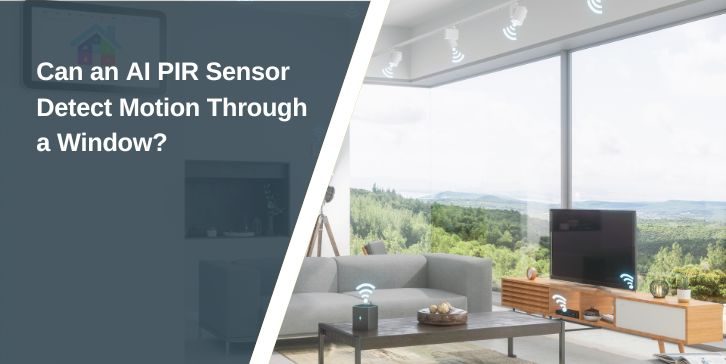Motion detection is a crucial feature in home security and smart automation systems, and Passive Infrared (PIR) sensors play a key role in detecting movement by sensing heat emitted by objects. Some users wonder if AI-enhanced PIR sensors can detect motion through windows, allowing indoor sensors to monitor outdoor activity.
The short answer is no—PIR sensors cannot reliably detect movement through glass because glass blocks infrared radiation, which is what PIR sensors use to detect objects. AI-enhanced PIR sensors may improve detection accuracy, but they cannot bypass the fundamental limitation of infrared-blocking materials like glass.
How Do PIR Sensors Detect Motion?
PIR sensors work by detecting changes in infrared (IR) radiation. When a warm object, such as a human or animal, moves within the sensor’s field of view, it disrupts the background infrared levels, triggering motion detection.
These sensors are commonly used in:
- Home security systems
- Automatic lighting
- Smart home automation
- Industrial motion detection
However, PIR sensors require a direct line of sight to detect heat signatures. This makes them ineffective through materials that block infrared radiation, such as glass, acrylic, and some plastics.
Why Can’t a PIR Sensor Detect Motion Through a Window?

A PIR sensor cannot detect motion through glass because infrared waves do not pass through it easily. Here are the main reasons why:
- Glass Blocks Infrared Radiation – Standard window glass does not transmit enough infrared heat for a PIR sensor to detect motion.
- Insulated and Tinted Glass Worsens the Effect – Double-glazed, UV-coated, and insulated glass reduces infrared transmission even further.
- AI Motion Detection Does Not Bypass Physical Limitations – AI enhances object classification but does not change the fact that PIR sensors rely on infrared signals, which are blocked by glass.
- Reflections Can Cause False Readings – Sunlight, indoor heating, or reflections on glass may create incorrect motion triggers or interfere with the sensor.
Because of these factors, even an AI-enhanced PIR sensor will not detect motion through a window.
Are There Any Exceptions?
There are limited cases where a PIR sensor might partially detect motion through glass, but the reliability is low.
- Thin, non-insulated glass may allow some infrared radiation to pass, but detection remains inconsistent.
- If a window is slightly open, infrared waves can reach the sensor, allowing motion detection.
- Specialized infrared-transparent materials exist, but they are not commonly used in standard windows.
Despite these rare cases, a PIR sensor is not designed to detect motion through a standard glass window.
Best Alternatives for Detecting Motion Through a Window
Since PIR sensors are ineffective through glass, here are better options for detecting motion outside a window:
- Microwave Motion Sensors – Unlike PIR sensors, microwave-based motion detectors use radio waves that penetrate glass, making them a reliable alternative.
- AI-Based Security Cameras – AI-powered cameras use video analysis instead of infrared detection, allowing them to recognize movement through windows.
- Outdoor PIR Sensors – Instead of placing a PIR sensor inside, installing one outside ensures it detects motion without obstruction.
- Radar-Based Motion Sensors – These use electromagnetic waves that pass through windows, making them another viable option for through-glass detection.
For home security, combining AI-powered cameras with outdoor motion sensors provides the most effective solution.
Future of Motion Detection: Will AI Overcome This Limitation?
While AI has improved security technology, it cannot change how infrared radiation interacts with glass. However, hybrid motion detection systems that combine PIR, microwave, radar, and AI-driven object tracking are being developed to provide more accurate motion detection in complex environments.
The future may bring more advanced sensors that integrate multiple technologies, but for now, PIR sensors remain ineffective for detecting motion through windows.
Conclusion: Can an AI PIR Sensor Detect Motion Through a Window?
No, AI PIR sensors cannot reliably detect motion through glass because infrared radiation is blocked by window materials. AI-enhanced motion detection improves accuracy within direct line-of-sight environments, but it does not change the physical limitations of infrared waves.
For motion detection through windows, better alternatives include microwave motion sensors, AI-powered security cameras, and radar-based sensors. Installing outdoor PIR sensors also eliminates the need for through-glass detection.
Understanding how different motion sensors work can help in choosing the best security setup for your home or business.




